Impact of Underground Space Height and BMI on Children’s Fatigue During Ascending Evacuation: An Experimental Study and Intelligent Assistive Implications
Abstract
1. Introduction
2. Methods
2.1. Experimental Site and Equipment Selection
2.1.1. Selection of Experimental Site
2.1.2. Selection of Experimental Equipment
2.2. Participant Information
2.3. The Experimental Procedure
2.4. The Data Analysis Method
3. Results
3.1. Analysis of Heart Rate and Fatigue Level During Ascending Evacuation
3.2. Relationship Between Ascending Height and Participants’ Heart Rate (HR) During Ascending Evacuation
3.3. Relationship Between BMI and Participants’ Heart Rate (HR) During Ascending Evacuation
3.4. Mathematical Relationship Between Participants’ BMI and Heart Rate (HR) During Ascending Evacuation
4. Discussion
4.1. Relationship Between Ascending Height and Heart Rate (HR) During Upward Evacuation
4.2. Relationship Between BMI and Participants’ HR During Ascending Evacuation
4.3. An Exploratory Study on Intelligent Safety Assistance Design for Fire Escape Stairways
4.4. Limitations of This Study
5. Conclusions
- (1)
- The experimental results revealed a highly significant positive correlation between ascending evacuation height and changes in children’s HR (p < 0.01). During the initial phase, HR increased gradually; in the middle phase, gender-based differences in the rate of increase began to emerge; and in the final phase, HR rose sharply, indicating rapid fatigue accumulation. Overall, the HR increase among female children (16.42%) was substantially greater than that among male children (9.07%), with the final average HR for girls exceeding that of boys by 4.09%.
- (2)
- This study discovered that BMI had a significant effect on fatigue levels across varying ascending evacuation heights (p < 0.01) and developed a fatigue prediction model applicable to children in different BMI categories for evacuation heights of 12 m or less. Furthermore, in the obese female group, once the evacuation height exceeded 12 m, the influence of BMI on fatigue diminished, with physiological limits becoming the dominant factor regulating HR. At this stage, BMI ceased to be the primary determinant.
Author Contributions
Funding
Institutional Review Board Statement
Informed Consent Statement
Data Availability Statement
Acknowledgments
Conflicts of Interest
Abbreviations
| BMI | Body Mass Index |
| HR | Heart Rate |
| SD | Standard Deviation |
| PID | Pedestrian Identification Device |
| HUD | Height Ultrasonic Detector |
| CPD | Central Processing Device |
| ALD | Alarm Device |
| KHC | Knee-and-Hand Crawling |
| UW | Upright Walking |
| SW | Stoop Walking |
| CI | Confidence Interval (indirectly implied via statistical context, optional inclusion) |
| WS | Weight Sensor |
References
- Cui, C.; Shao, Q.; Liu, Y.; Han, G.; Liu, F.; Han, X. A review of the evolution and trends in research on the emergency evacuation of urban underground spaces. Buildings 2023, 13, 1325. [Google Scholar] [CrossRef]
- Shi, C.; Zhong, M.; Nong, X.; He, L.; Shi, J.; Feng, G. Modeling and safety strategy of passenger evacuation in a metro station in China. Saf. Sci. 2012, 50, 1319–1332. [Google Scholar] [CrossRef]
- Lee, S. A study on the changing architectural properties of mixed-use commercial complexes in Seoul, Korea. Sustainability 2022, 14, 2649. [Google Scholar] [CrossRef]
- Xu, S. Development and use of underground space for entertainment and cultural activities in the People’s Republic of China. Tunnell. Undergr. Space Technol. 1987, 2, 269–273. [Google Scholar] [CrossRef]
- Zhang, P. Japanese ways of developing urban underground recreation space. World J. Eng. Technol. 2018, 6, 504–517. [Google Scholar] [CrossRef]
- Wu, W.; Yun, Y.; Sun, Y.; Zhang, G. The geography of subway development and commuting behavior. Tunnell. Undergr. Space Technol. 2023, 133, 104941. [Google Scholar] [CrossRef]
- Li, Q.; Xia, J.; Xie, Z.; Zhou, M.; Deng, S. Hazard and vulnerability in urban inundated underground space: Hydrodynamic analysis of human instability for stairway evacuation. Int. J. Disaster Risk Reduct. 2022, 70, 102754. [Google Scholar] [CrossRef]
- Li, J.; Qi, Z.; Li, Y.; Chow, W.-K.; Xie, F.; Dong, Q. Field measurements of free ascending behavior of occupants along medium-long stairway. Appl. Sci. 2022, 12, 10038. [Google Scholar] [CrossRef]
- Xu, H.; Yu, M.; Huang, H.; Fan, Y. A preliminary study on the comprehensive evaluation of the disaster prevention system of large urban underground space. In Geotechnical Safety and Risk V; IOS Press: Amsterdam, The Netherlands, 2015; pp. 457–462. [Google Scholar]
- Li, H.; Lo, J.T.Y.; Lo, S. The impact of preschool children requiring adult assistance on evacuation efficiency. Simul. Modell. Pract. Theory 2025, 139, 103062. [Google Scholar] [CrossRef]
- Fang, Z.M.; Jiang, L.X.; Li, X.L.; Qi, W.; Chen, L.Z. Experimental study on the movement characteristics of 5–6 years old Chinese children when egressing from a pre-school building. Saf. Sci. 2019, 113, 264–275. [Google Scholar] [CrossRef]
- Hamilton, G.N.; Lennon, P.F.; O’Raw, J. Human behaviour during evacuation of primary schools: Investigations on pre-evacuation times, movement on stairways and movement on the horizontal plane. Fire Saf. J. 2017, 91, 937–946. [Google Scholar] [CrossRef]
- Yeo, S.K.; He, Y. Commuter characteristics in mass rapid transit stations in Singapore. Fire Saf. J. 2009, 44, 183–191. [Google Scholar] [CrossRef]
- Storm, A.; Celander, E.S. Field evacuation experiment in a long inclined tunnel. Fire Saf. J. 2022, 132, 103640. [Google Scholar] [CrossRef]
- Fu, Z.; Zhan, X.; Luo, L.; Schadschneider, A.; Chen, J. Modeling fatigue of ascending stair evacuation with modified fine discrete floor field cellular automata. Phys. Lett. A 2019, 383, 1897–1906. [Google Scholar] [CrossRef]
- Li, N.; Wang, D.; Zheng, F.; Zhou, T. The impact of staircase slope on upward evacuation efficiency. Saf. Sci. 2025, 181, 106675. [Google Scholar] [CrossRef]
- Lu, T.; Zhao, Y.; Wu, P.; Zhu, P. Pedestrian ascent and descent behavior characteristics during staircase evacuation under invisible conditions. Saf. Sci. 2021, 143, 105441. [Google Scholar] [CrossRef]
- Jiang, R.; Wang, Y.; Xie, R.; Zhou, T.; Wang, D. Effect of stairway handrails on pedestrian fatigue and speed during ascending evacuation. ASCE-ASME J. Risk Uncertain. Eng. Syst. Part A Civil Eng. 2022, 8, 06022001. [Google Scholar] [CrossRef]
- Gao, J.; Gong, J.; He, J.; Zhang, D.; Qiu, G.; Zhang, J. Experimental study on pedestrians’ uni- and bi-directional movement on staircases under emergency conditions. J. Stati. Mech. Theory Exp. 2020, 2020, 103401. [Google Scholar] [CrossRef]
- Delin, M.; Norén, J.; Ronchi, E.; Kuklane, K.; Halder, A.; Fridolf, K. Ascending stair evacuation: Walking speed as a function of height. Fire Mater. 2017, 41, 514–534. [Google Scholar] [CrossRef]
- Pan, F.; Zhang, L.; Qi, R.; Ma, C.; Yang, J.; Tang, H. Analysis of psychologies and behaviors of subway crowds under special events based on survey. J. Transp. Saf. Secur. 2021, 13, 460–475. [Google Scholar] [CrossRef]
- Yang, X.; Jiang, H.; Li, Y.; Pan, F.; Yang, J. Prediction of evacuation time and safety evaluation for passengers ascending stairs in subway stations. China Saf. Sci. J. 2023, 33, 168–173. [Google Scholar] [CrossRef]
- Jia, X.; Zhang, B.; Gao, X.; Zhou, J. An ergonomic assessment of different postures and children risk during evacuations. Int. J. Environ. Res. Public Health 2021, 18, 12029. [Google Scholar] [CrossRef]
- Zeng, Y.; Song, W.; Jin, S.; Ye, R.; Liu, X. Experimental study on walking preference during high-rise stair evacuation under different ground illuminations. Phys. A Stat. Mech. Appl. 2017, 479, 26–37. [Google Scholar] [CrossRef]
- Zhang, B.; Gao, X.; Zhou, J.; Jia, X. The associations between evacuation movements and children’s physiological demands analyzed via wearable-based sensors. Sensors 2022, 22, 8094. [Google Scholar] [CrossRef]
- Bernardini, G.; Azzolini, M.; D’Orazio, M.; Quagliarini, E. Intelligent evacuation guidance systems for improving fire safety of Italian-style historical theatres without altering their architectural characteristics. J. Cult. Herit. 2016, 22, 1006–1018. [Google Scholar] [CrossRef]
- Chou, J.S.; Cheng, M.Y.; Hsieh, Y.M.; Yang, I.T.; Hsu, H.T. Optimal path planning in real time for dynamic building fire rescue operations using wireless sensors and visual guidance. Autom. Construct. 2019, 99, 1–17. [Google Scholar] [CrossRef]
- Lujak, M.; Billhardt, H.; Dunkel, J.; Fernández, A.; Hermoso, R.; Ossowski, S. A distributed architecture for real-time evacuation guidance in large smart buildings. Comput. Sci. Inform. Syst. 2017, 14, 257–282. [Google Scholar] [CrossRef]
- Zhang, J.; Guo, J.; Xiong, H.; Liu, X.; Zhang, D. A framework for an intelligent and personalized fire evacuation management system. Sensors 2019, 19, 3128. [Google Scholar] [CrossRef]
- Strutzenberger, G.; Richter, A.; Schneider, M.; Mündermann, A.; Schwameder, H. Effects of obesity on the biomechanics of stair-walking in children. Gait Post. 2011, 34, 119–125. [Google Scholar] [CrossRef]
- Song, Q.; Yu, B.; Zhang, C.; Sun, W.; Mao, D. Effects of backpack weight on posture, gait patterns and ground reaction forces of male children with obesity during stair descent. Res. Sports Med. 2014, 22, 172–184. [Google Scholar] [CrossRef]
- Yao, Y.; Lu, W. Children’s evacuation behavioural data of drills and simulation of the horizontal plane in kindergarten. Saf. Sci. 2021, 133, 105037. [Google Scholar] [CrossRef]
- Yao, Y.; Lu, W.; Wang, L. Experimental study on evacuation behaviour of children in a three-storey kindergarten. Heliyon 2023, 9, e16533. [Google Scholar] [CrossRef] [PubMed]
- Kholshchevnikov, V.V.; Samoshin, D.A.; Parfyonenko, A.P.; Belosokhov, I.P. Study of children evacuation from pre-school education institutions. Fire Mater. 2012, 36, 349–366. [Google Scholar] [CrossRef]
- Pan, G.; Peng, M.; Zhou, T.; Wan, Z.; Liang, Z. Research on Safety design strategy of evacuation stairs in deep underground station based on human heart rate and ascending evacuation speed. Sustainability 2023, 15, 10670. [Google Scholar] [CrossRef]
- Xie, R.; Pan, Y.; Zhou, T.; Ye, W. Smart safety design for fire stairways in underground space based on the ascending evacuation speed and BMI. Saf. Sci. 2020, 125, 104619. [Google Scholar] [CrossRef]
- Strutzenberger, G.; Alexander, N.; Bamboschek, D.; Claas, E.; Langhof, H.; Schwameder, H. Uphill walking: Biomechanical demand on the lower extremities of obese adolescents. Gait Post. 2017, 54, 20–26. [Google Scholar] [CrossRef]
- Shi, D.; Liu, J.; Ma, J.; Lovreglio, R.; Wang, Q.; Chen, J. How do age compositions affect pedestrian dynamics on stairways? Findings from controlled experiments. Saf. Sci. 2024, 178, 106623. [Google Scholar] [CrossRef]
- Norén, J.; Delin, M.; Fridolf, K. Ascending stair evacuation: What do we know? Transp. Res. Proced. 2014, 2, 774–782. [Google Scholar] [CrossRef]
- Chen, J.; Liu, R.; Wang, J.; Chen, Y. Experimental influence of pedestrian load on individual and group evacuation speed in staircases. Fire Technol. 2017, 53, 1745–1763. [Google Scholar] [CrossRef]
- Choi, J.H.; Galea, E.R.; Hong, W.H. Individual stair ascent and descent walk speeds measured in a Korean high-rise building. Fire Technol. 2014, 50, 267–295. [Google Scholar] [CrossRef]
- Kretz, T.; Grünebohm, A.; Kessel, A.; Klüpfel, H.; Meyer-König, T.; Schreckenberg, M. Upstairs walking speed distributions on a long stairway. Saf. Sci. 2008, 46, 72–78. [Google Scholar] [CrossRef]
- Ministry of Housing and Urban-Rural Development. Code for Fire Protection Design of Buildings GB50016-2014, 2018 ed; China Planning Publishing House: Beijing, China, 2020. [Google Scholar]
- Halder, A.; Kuklane, K.; Gao, C.; Miller, M.; Delin, M.; Norén, J.; Fridolf, K. Limitations of oxygen uptake and leg muscle activity during ascending evacuation in stairways. Appl. Ergonom. 2018, 66, 52–63. [Google Scholar] [CrossRef] [PubMed]
- Ni, Z.; Sun, F.; Li, Y. Heart rate variability-based subjective physical fatigue assessment. Sensors 2022, 22, 3199. [Google Scholar] [CrossRef]
- Chen, J.J.; Jiang, Y.R. Standardized diagnosis and assessment of overweight or obesity in children. Chin. J. Pediatr. 2024, 62, 494–496. [Google Scholar] [CrossRef]
- Li, H.; Ji, C.Y.; Zong, X.N.; Zhang, Y.Q. Body mass index growth curves for Chinese children and adolescents aged 0 to 18 years. Chin. J. Pediatr. 2009, 47, 493–498. [Google Scholar] [CrossRef]
- Ding, Z.; Du, L. Use of BMI/Kaup index to assess obesity in pediatrics. Chin. J. Pediatr. 2002, 40, 33–35. [Google Scholar]
- Ronchi, E.; Norén, J.; Delin, M.; Kuklane, K.; Halder, A.; Arias, S.; Fridolf, K. Ascending Evacuation in Long Stairways: Physical Exertion, Walking Speed and Behaviour; Department of Fire Safety Engineering, Lund University: Lund, Sweden, 2015; Volume 3192. [Google Scholar]
- Chen, J.; Wang, J.; Wang, J.; Liu, X.; Li, T.; Lin, P. An experimental study of individual ascent speed on long stair. Fire Technol. 2017, 53, 283–300. [Google Scholar] [CrossRef]
- de Zambotti, M.; Javitz, H.; Franzen, P.L.; Brumback, T.; Clark, D.B.; Colrain, I.M.; Baker, F.C. Sex- and age-dependent differences in autonomic nervous system functioning in adolescents. J. Adolesc. Health 2018, 62, 184–190. [Google Scholar] [CrossRef]
- Taylor, R.; Gold, E.; Manning, P.; Goulding, A. Gender differences in body fat content are present well before puberty. Int. J. Obesity 1997, 21, 1082–1084. [Google Scholar] [CrossRef]
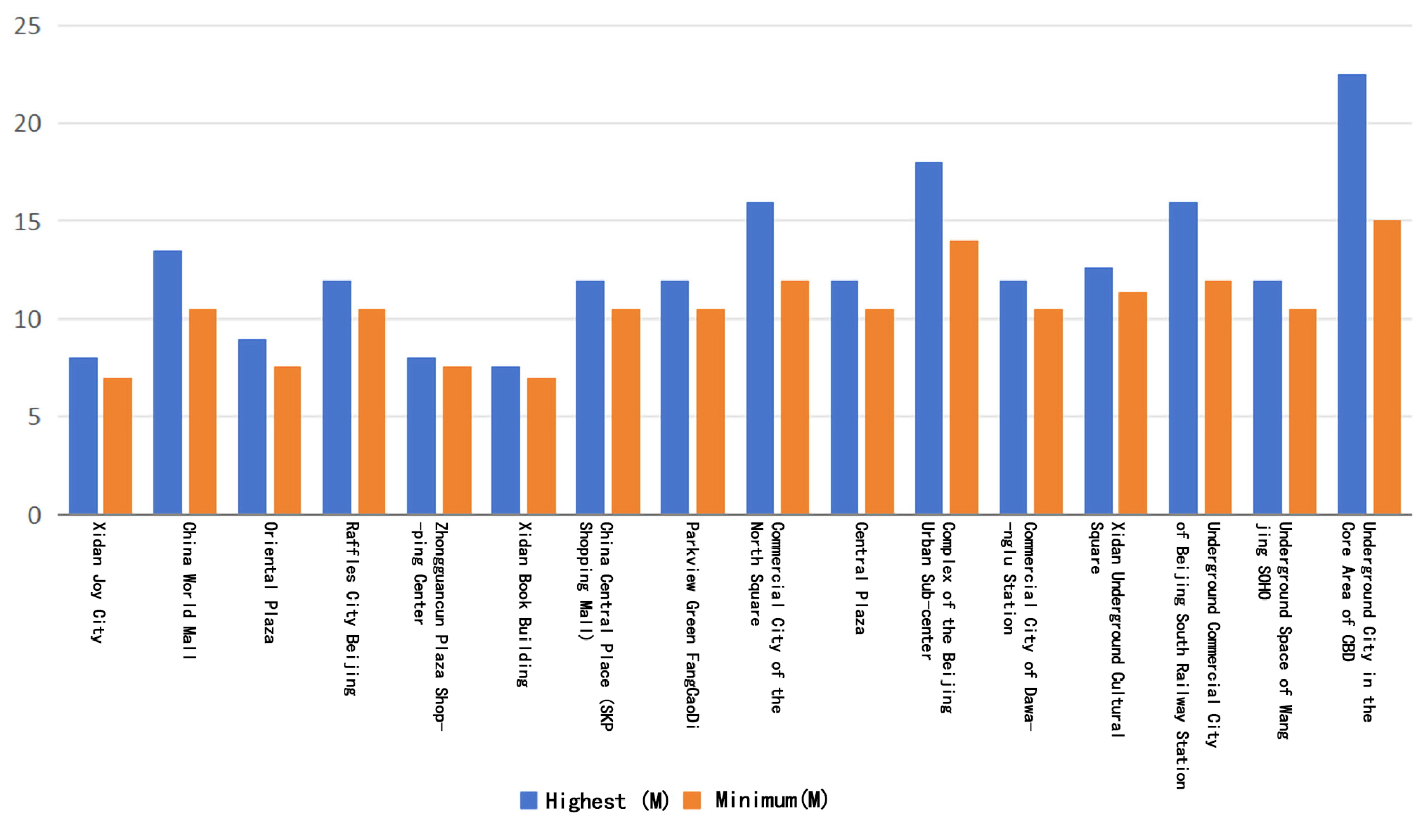
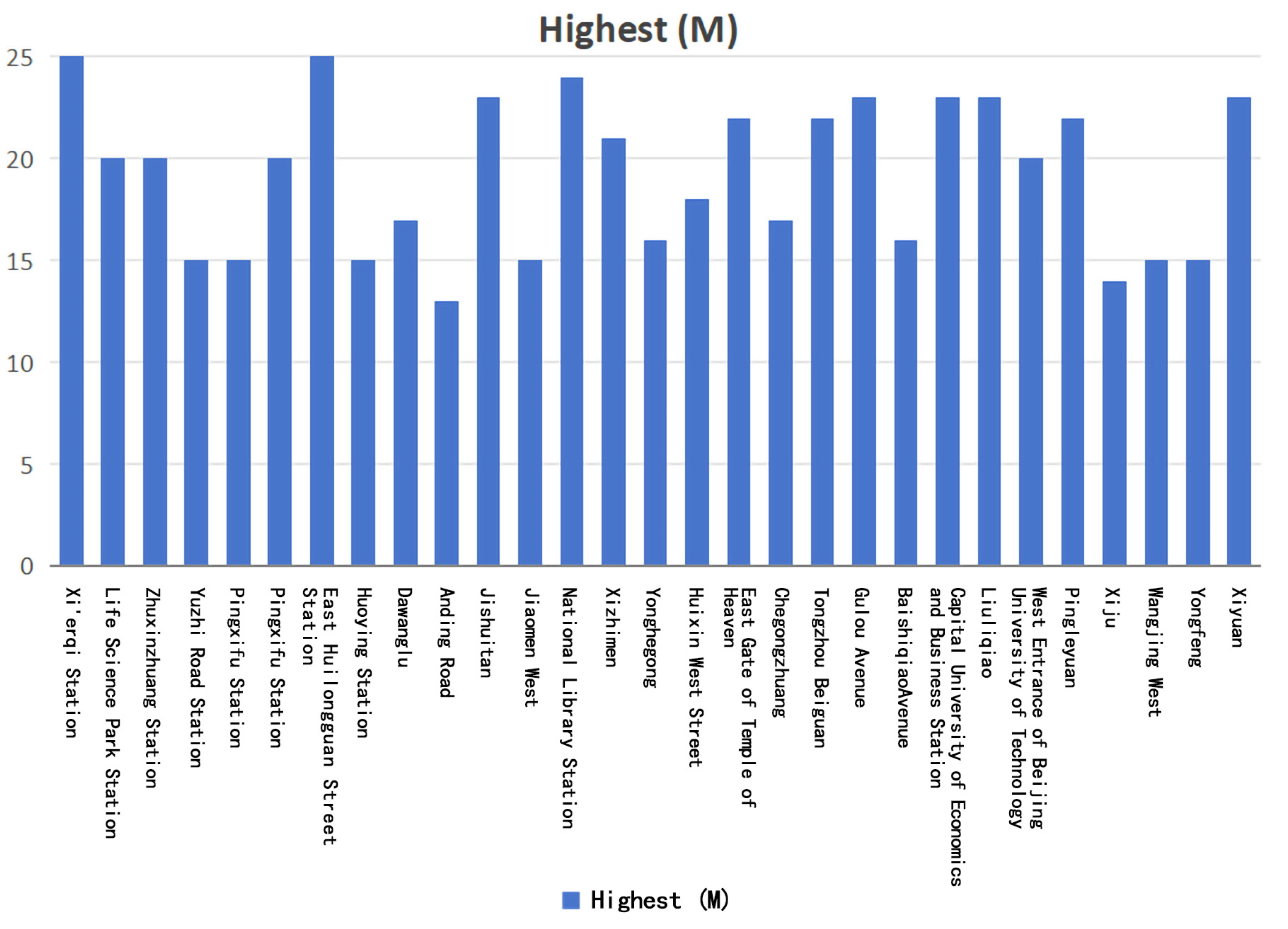
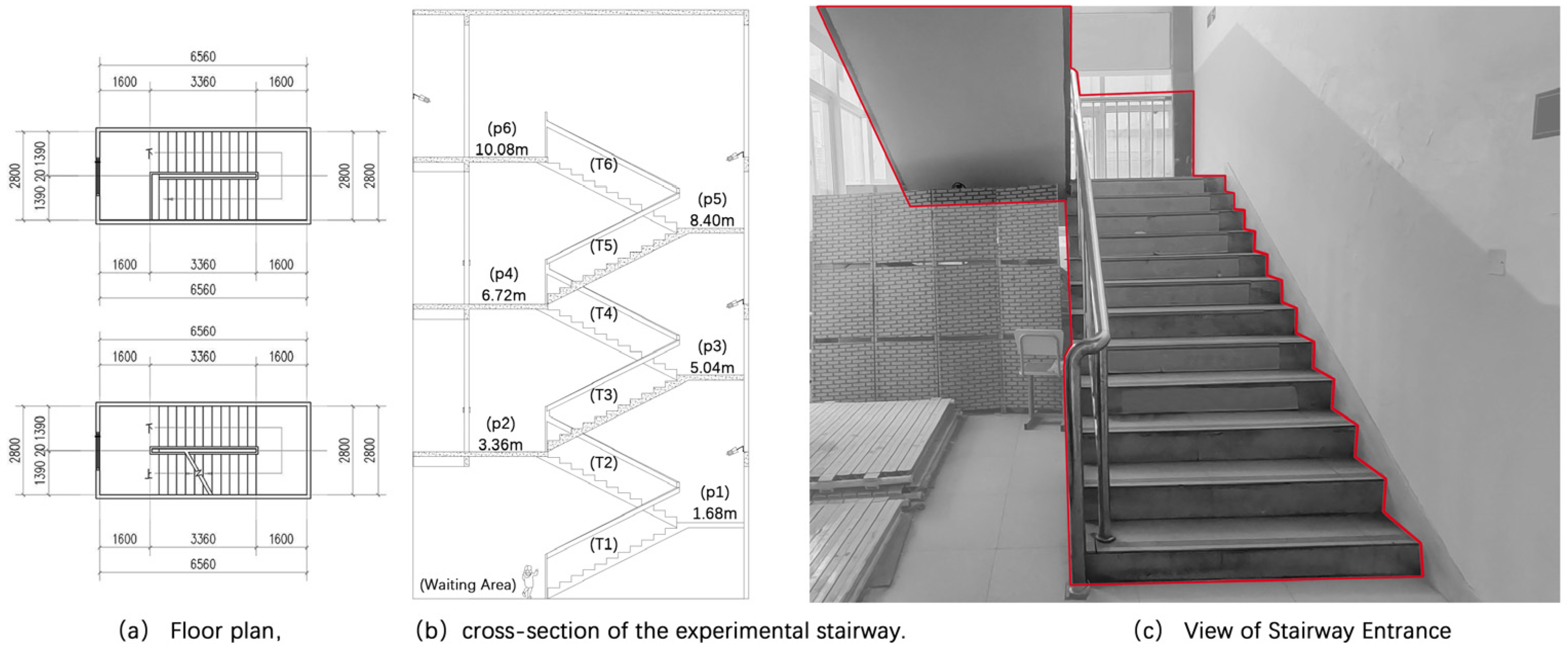
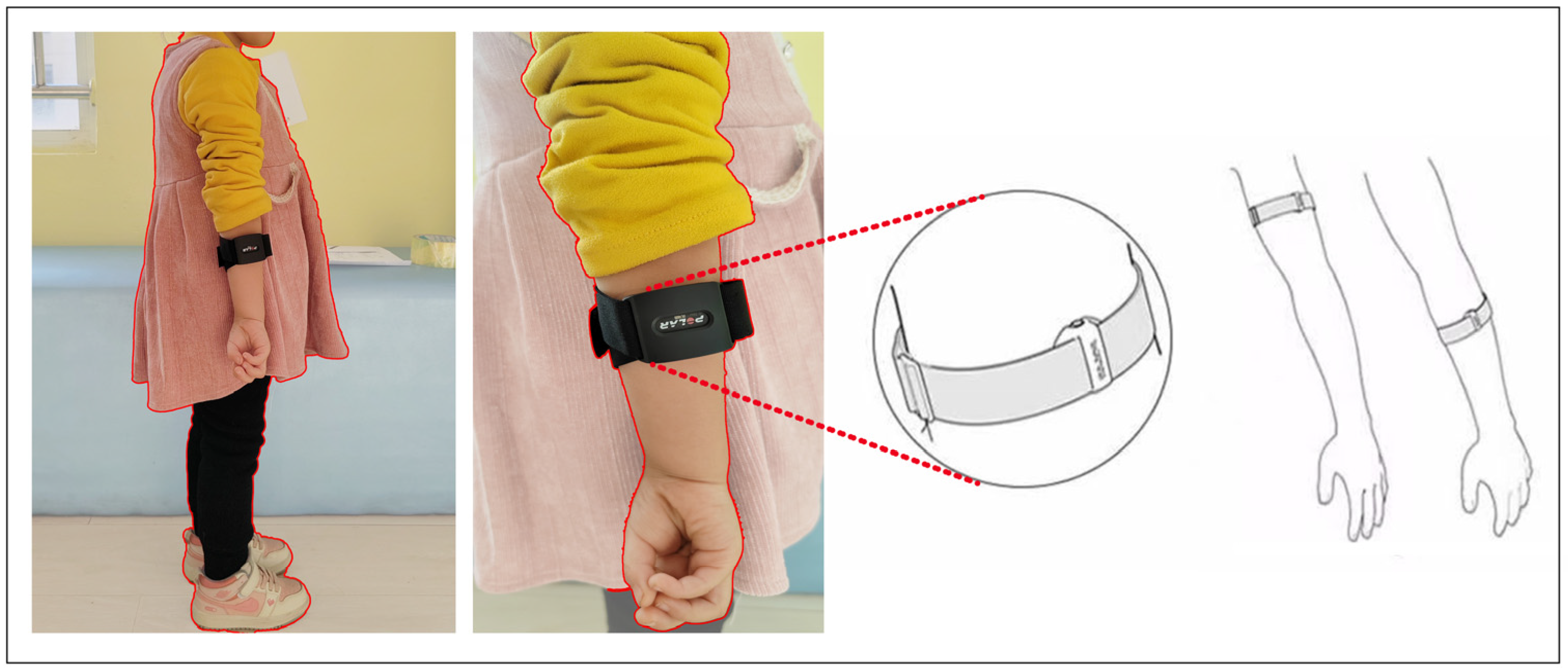

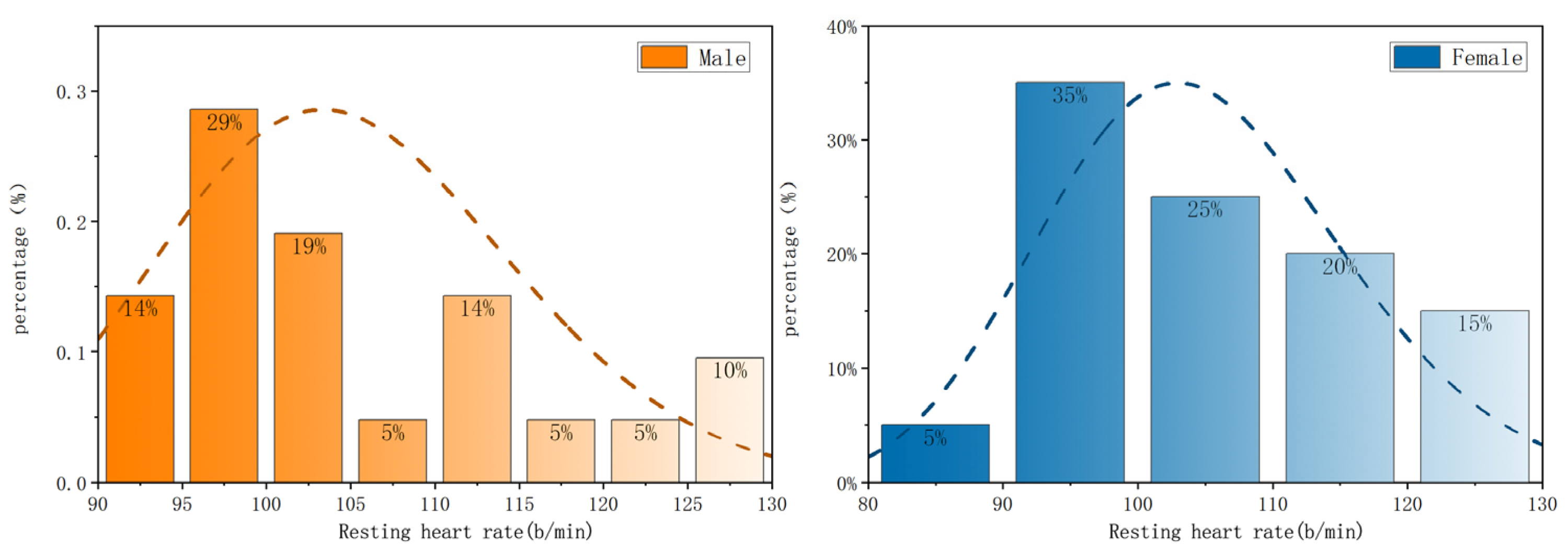
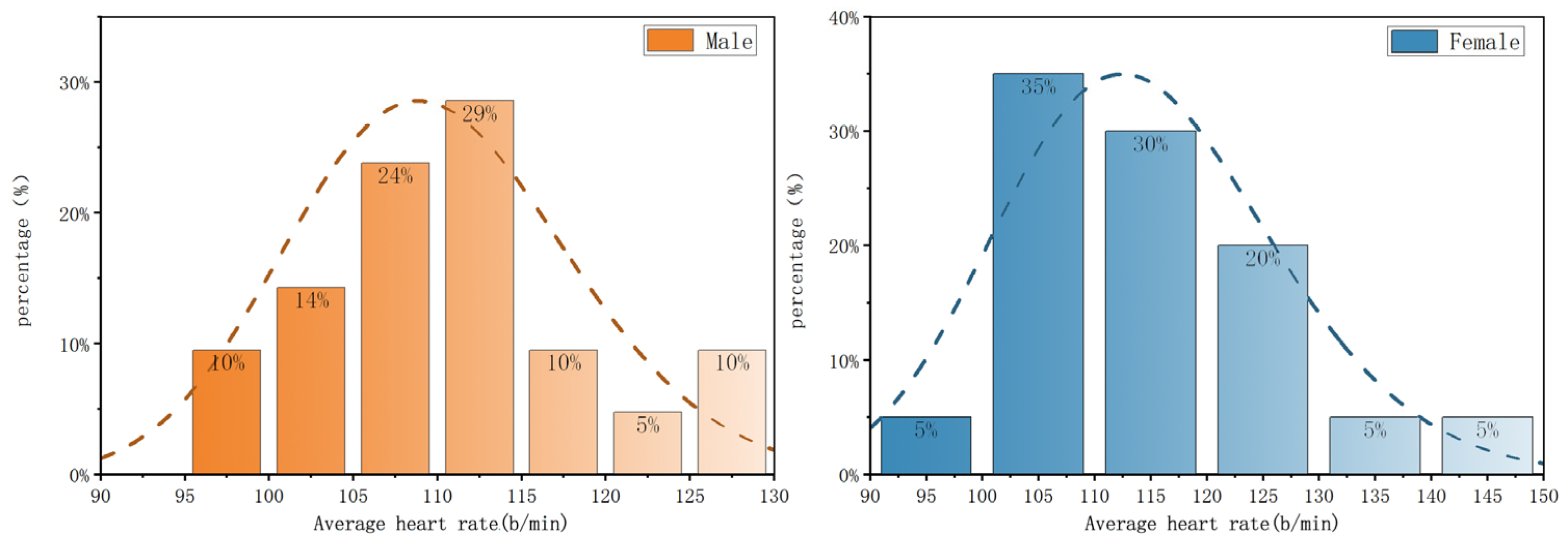
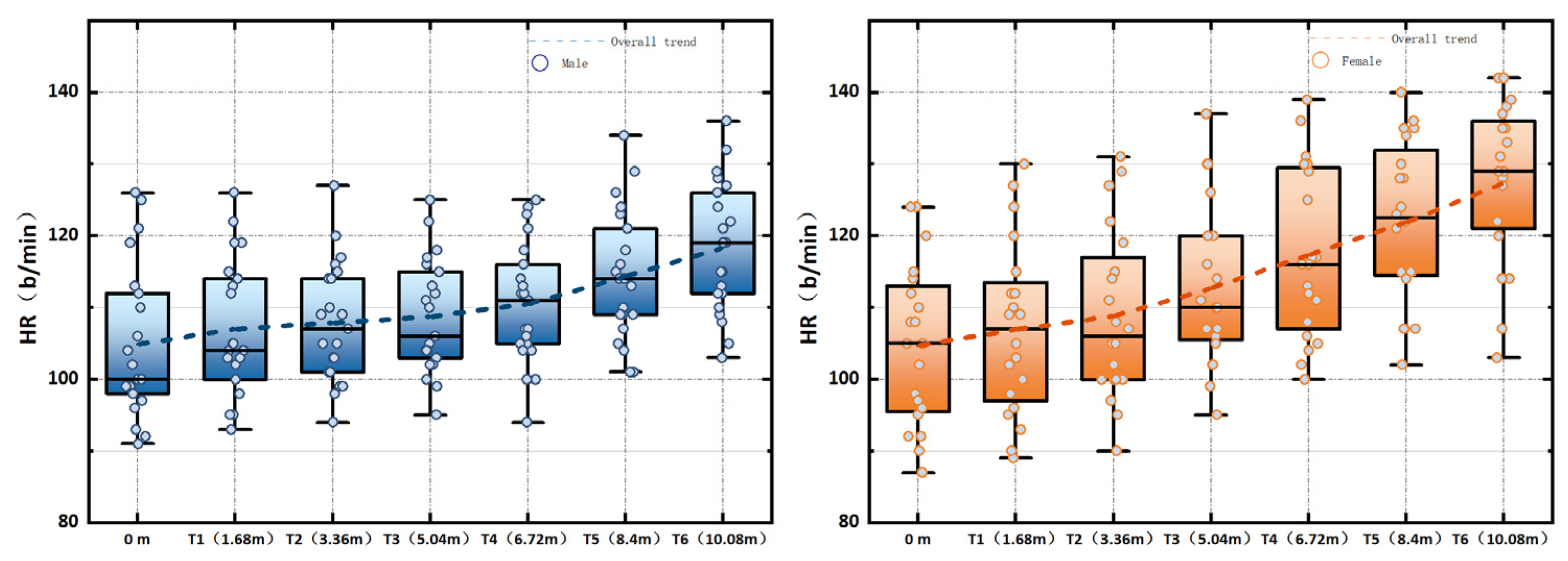
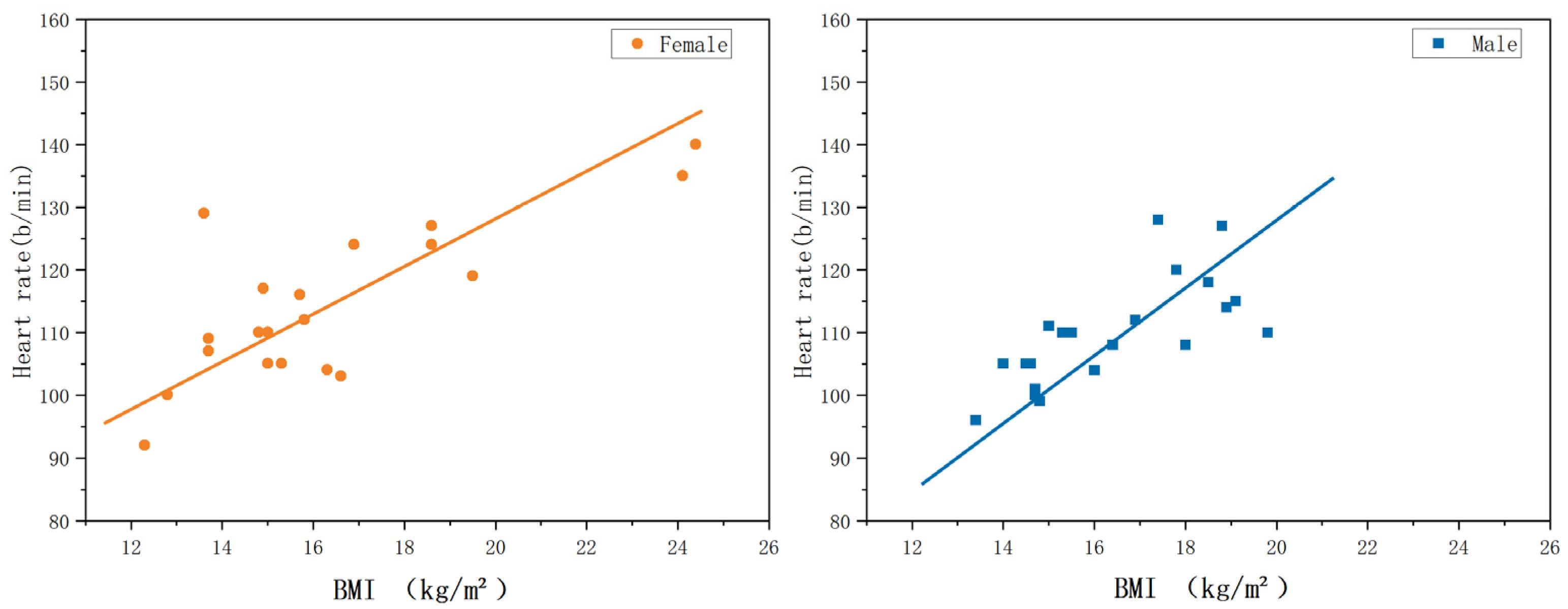


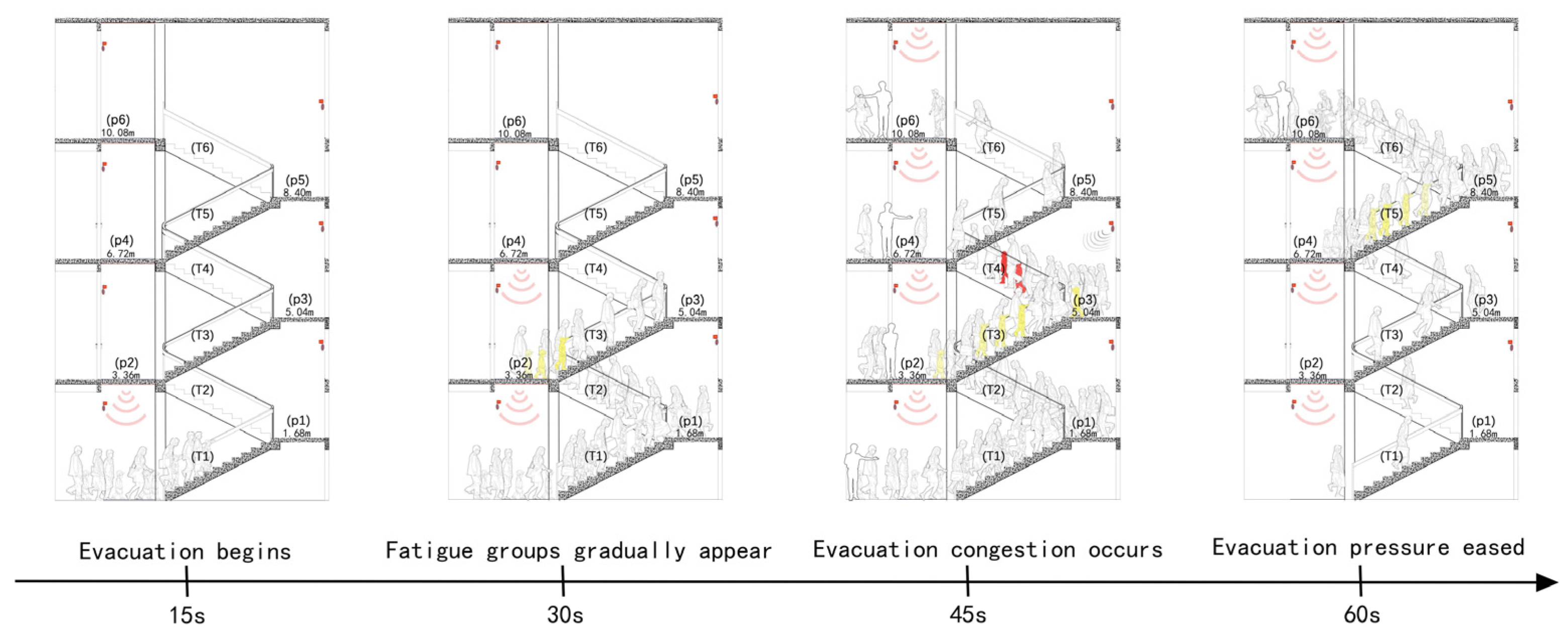
| Group | Personnel Quantity | Age (Mean) | BMI Range (kg/m2) | Mean Height (m) | Mean Body Weight (kg) | ||
|---|---|---|---|---|---|---|---|
| Age (Years) | Male | Female | |||||
| Thin Group A | Male (5), Female (5) | 5.35 | 4 | BMI < 13.6 | BMI < 13.4 | 114.6 | 17.6 |
| 5 | BMI < 13.6 | BMI < 13.5 | |||||
| 6 | BMI < 13.7 | BMI < 13.6 | |||||
| Normal Group B | Male (4), Female (7) | 5.09 | 4 | 13.6 ≤ BMI < 15.7 | 13.4 ≤ BMI < 15.5 | 114.6 | 17.6 |
| 5 | 13.6 ≤ BMI < 15.7 | 13.5 ≤ BMI < 15.6 | |||||
| 6 | 13.7 ≤ BMI < 15.9 | 13.6 ≤ BMI < 15.8 | |||||
| Overweight Group C | Male (7), Female (3) | 5.35 | 4 | 15.7 ≤ BMI < 17.4 | 15.5 ≤ BMI < 17.1 | 119.2 | 23.8 |
| 5 | 15.7 ≤ BMI < 17.4 | 15.6 ≤ BMI < 17.2 | |||||
| 6 | 15.9 ≤ BMI < 17.7 | 15.8 ≤ BMI < 17.5 | |||||
| Obese Group D | Male (5), Female (5) | 5.20 | 4 | BMI ≥ 17.4 | BMI ≥ 17.1 | 118.2 | 28.0 |
| 5 | BMI ≥ 17.4 | BMI ≥ 17.2 | |||||
| 6 | BMI ≥ 17.7 | BMI ≥ 17.5 | |||||
| Heart Rate (HR) | Rang (b/min) | Average HR (b/min) | SD | Resting HR (b/min) | SD |
|---|---|---|---|---|---|
| Overall participants (HR) | 87–142 | 112.05 | 9.7 | 104.92 | 10.11 |
| Male participants (HR) | 91–136 | 109.81 | 8.28 | 105.14 | 10.05 |
| Female participants (HR) | 87–142 | 114.30 | 12.08 | 104.70 | 10.97 |
| Heart Rate (HR) | Resting HR | T1 (1.68 m) | T2 (3.36 m) | T3 (5.04 m) | T4 (6.72 m) | T5 (8.4 m) | T6 (10.08 m) | |||||||
|---|---|---|---|---|---|---|---|---|---|---|---|---|---|---|
| Mean 95% Confidence Interval | Mean 95% Confidence Interval | Mean 95% Confidence Interval | Mean 95% Confidence Interval | Mean 95% Confidence Interval | Mean 95% Confidence Interval | Mean 95% Confidence Interval | ||||||||
| Min | Max | Min | Max | Min | Max | Min | Max | Min | Max | Min | Max | Min | Max | |
| Overall participant HR (b/min) | 99.46 | 108.74 | 102.46 | 110.74 | 104.24 | 111.27 | 105.13 | 112.47 | 106.42 | 114.68 | 109.99 | 118.10 | 114.41 | 122.49 |
| Male participant HR (b/min) | 99.46 | 108.74 | 102.46 | 110.74 | 104.24 | 111.27 | 105.13 | 112.47 | 106.42 | 114.68 | 109.99 | 118.10 | 114.41 | 122.49 |
| Female participant HR (b/min) | 99.43 | 109.97 | 101.30 | 112.60 | 103.32 | 114.38 | 107.40 | 118.00 | 111.78 | 122.92 | 116.61 | 127.19 | 122.07 | 132.63 |
| Total (n = 41) | Correlation | Male (n = 21) | Correlation | Female (n = 20) | Correlation | |
|---|---|---|---|---|---|---|
| Upward height (m) | 10.73 (SD = 5.07) | 0.979 ** | 10.70 (SD = 5.14) | 0.958 ** | 10.75 (SD = 5.00) | 0.986 ** |
| Male (n = 21) | Female (n = 20) | |||
|---|---|---|---|---|
| Group | Mean HR (b/min) | SD | Mean HR (b/min) | SD |
| Thin Group A | 102.4 | 3.56 | 107.4 | 12.34 |
| Normal Group B | 105 | 5.52 | 110.71 | 4.40 |
| Overweight Group C | 112.86 | 7.70 | 110.33 | 9.67 |
| Obese Group D | 116.8 | 5.71 | 129 | 7.56 |
| Total (n = 41) | Correlation | Male (n = 21) | Correlation | Female (n = 20) | Correlation | |
|---|---|---|---|---|---|---|
| HR (b/min) | 112.05 (SD = 10.56) | 0.693 ** | 109.81 (SD = 8.28) | 0.527 * | 114.3 (SD = 12.08) | 0.723 ** |
| Age (years) | 5.2 (SD = 0.54) | 0.007 | 5.26 (SD = 0.56) | −0.215 | 5.22 (SD = 0.55) | 0.21 |
| Weight (kg) | 22.36 (SD = 5.01) | 0.489 ** | 23.23 (SD = 4.25) | 0.054 | 21.44 (SD = 5.67) | 0.572 ** |
| BMI (kg/m2) | 16.38 (SD = 2.61) | 0.693 ** | 16.39 (SD = 1.89) | 0.527 * | 16.38 (SD = 3.21) | 0.723 ** |
Disclaimer/Publisher’s Note: The statements, opinions and data contained in all publications are solely those of the individual author(s) and contributor(s) and not of MDPI and/or the editor(s). MDPI and/or the editor(s) disclaim responsibility for any injury to people or property resulting from any ideas, methods, instructions or products referred to in the content. |
© 2025 by the authors. Licensee MDPI, Basel, Switzerland. This article is an open access article distributed under the terms and conditions of the Creative Commons Attribution (CC BY) license (https://creativecommons.org/licenses/by/4.0/).
Share and Cite
Liu, M.; Zhang, H.; Guo, X.; Feng, Y.; Zhao, X.; Xuan, C.; Jia, X. Impact of Underground Space Height and BMI on Children’s Fatigue During Ascending Evacuation: An Experimental Study and Intelligent Assistive Implications. Buildings 2025, 15, 2017. https://doi.org/10.3390/buildings15122017
Liu M, Zhang H, Guo X, Feng Y, Zhao X, Xuan C, Jia X. Impact of Underground Space Height and BMI on Children’s Fatigue During Ascending Evacuation: An Experimental Study and Intelligent Assistive Implications. Buildings. 2025; 15(12):2017. https://doi.org/10.3390/buildings15122017
Chicago/Turabian StyleLiu, Ming, Hu Zhang, Xin Guo, Yongbo Feng, Xiaochen Zhao, Changzheng Xuan, and Xiaohu Jia. 2025. "Impact of Underground Space Height and BMI on Children’s Fatigue During Ascending Evacuation: An Experimental Study and Intelligent Assistive Implications" Buildings 15, no. 12: 2017. https://doi.org/10.3390/buildings15122017
APA StyleLiu, M., Zhang, H., Guo, X., Feng, Y., Zhao, X., Xuan, C., & Jia, X. (2025). Impact of Underground Space Height and BMI on Children’s Fatigue During Ascending Evacuation: An Experimental Study and Intelligent Assistive Implications. Buildings, 15(12), 2017. https://doi.org/10.3390/buildings15122017






